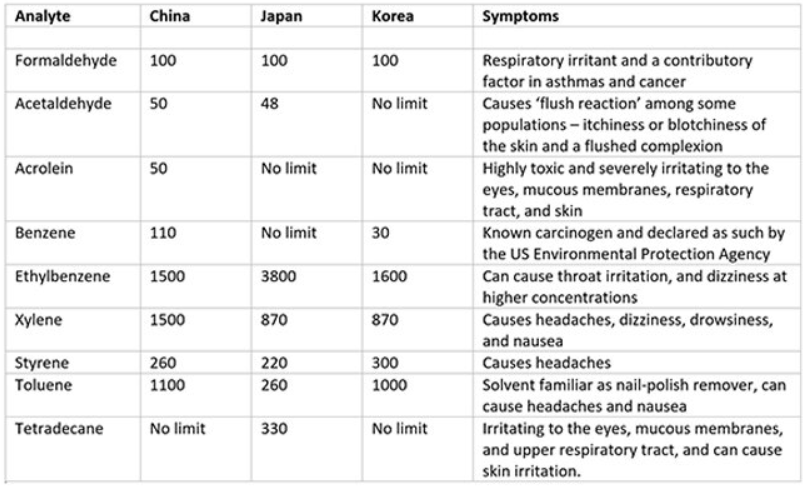So you’re in the market for a new car? With or without New Car Smell?
So you’re in the market for a new car? With or without New Car Smell?
If the idea of driving a new car is appealing, you may need to educate your nose to accept that the new car smell is not a good thing. Thankfully, many automakers are becoming conscious of the dangers of volatile organic compounds (VOCs) that compose most new car smells, and are taking steps to reduce them. Not a small driver for this is the new car market of China. Over 11% of buyers in China complained about the odors they found in their new cars, according to the 2019 JD Power China Initial Quality Study. (The Self-Poisoning Car) Apparently, Chinese prefer for their new cars to have no smell at all, which makes sense due to their genetics. Many Asians possess a less functional acetaldehyde dehydrogenase enzyme, which is responsible for breaking this VOC down, therefore they may be especially susceptible to its allergenic effects.
When you know about what is in the “new car smell”, you might not be too disappointed when it fades away! Most of the smells are due to VOCs, some toxic ones at worst. The sources are varied:
- Residual compounds from the manufacturing process and material treatment of different interior components and textiles. These include flame retardants (FRs), of which tris(1-chloro-isopropyl) phosphate (TCIPP) had a 99% detection frequency in a 2024 study. TCIPP was the dominant FR detected in the vehicle seat foam, and air concentrations of this chemical increased with increasing temperature.
- Adhesives and carrier solvents that will de-gas – as much as 2kg of adhesive can be found in a modern car, much higher than in the past where mechanical riveting and bolting was more common]
- Degradation of cabin materials over the longer term as a result of oxidation, ultra-violet light and heat.
There are no worldwide standards for interior VOCs on new cars, but Asian countries seem to have some of the most well-defined guidelines. Here are some of them:
Source: The Self-Poisoning Car
Testing VOCs with professional equipment can yield surprising results. Even in a 1-year old gasoline Hyundai i10 (an economy car produced in India but not sold in the US because it was deemed too lightweight), methanol and acetone rose dramatically as the car stood in the sun for 5 hours, only reaching 68 degrees F. After the five hour test without the engine on, the car was started, windows rolled up and AC on max with recirculation mode. This yielded another surprise: some VOCs such as acetaldehyde rose steeply during the fourth to sixth minutes. During this phase acetaldehyde concentrations rose from an initial base of approximately 50 to 550 μg/m3, more than ten times the regulated limit in China and Japan. It was suspected that the air conditioner acted as a “sink” for some VOCs, which was flushing them out during this time. (The Self-Poisoning Car)
VOCs in cars have even led to a new condition: Sick Car Syndrome (SCS), a phenomenon in which drivers and passengers experience short-term health problems owing to the accumulation of volatile organic compounds (VOCs) in vehicle cabins [1], [2] and is particularly prominent in new rarely used cars. The symptoms of SCS include irritation of the eyes, nose, and throat, headaches, and dizziness, among other symptoms, with potential long-term health consequences. (Elevated volatile organic compound emissions from coated thermoplastic polyester elastomer in automotive interior parts: Importance of plastic swelling)
Some solutions from automotive material suppliers include:
- UK company Aqdot has introduced the product Aqfresh, which is a powder composed of barrel-shaped molecules with a hollow hydrophobic cavity and polar portals, enabling them to tightly bind a wide spectrum of unwanted molecules. Aqfresh can be applied to textiles via dry impregnation, as well as by spraying and padding during the finishing process. It can also be incorporated via compounding or polymer masterbatch into rigid plastic parts such as dashboards and other trim pieces.
- 3M has developed low VOC adhesive tapes and a water-based spray-on adhesive (no VOCs) that meet the Japanese Automobile Manufacturers Association (JAMA) standards for nine substances with defined limits for vehicle indoor air quality (VIAQ).
- POM is an acronym for the chemical name polyoxymethylene. It is generally referred to as polyacetal or acetal resin. POM has a number of applications in cars where it replaces metal such as door locks, fuel system parts, door rollers, and clips to hold trim in place. It has properties of durability, oil and chemical resistance, and self-lubrication. However, traditionally POM was a source of formaldehyde. Polyplastics has developed a number of grades of POM that are low-VOC in its DURACON® POM LV Series.
Although there are some brands that historically have higher customer ratings for interior air quality (like Honda), the last comprehensive survey of new car VOCs was in 2012, and recent reports by individual automakers regarding interior VOCs are very hard to find. You can definitely call individual manufacturers and inquire about VOCs while shopping, but when it comes down to deciding,it’s best to see/test cars in person: What you see in a “floor model” may not be what you get in your delivered car, either, since a 2007 study showed that interior VOC emissions varied greatly between makes, models and trims and even within the same make/model/trim.
You can do a lot to rid your car’s interior of most of its VOCs. Here are some tips to do it (How to Get Rid of That New Car Smell (Step by Step))
- Heat, ventilation, and time are certainly the main ways to offgas a vehicle. You can heat it by putting it in the sun, by running the heating system, or even with space heaters (very carefully in a small space). When you are heating materials you are releasing the VOCs and also creating new VOCs (this study explains), so make sure when you are heating up the new vehicle you are airing it out substantially at the same time so that the gasses have somewhere to go. Windows should be open while you are heating the vehicle. Windows can also be left open anytime it’s safe to do so.
- Deep clean the vehicle with non-toxic products:
- You can use AFM Carpet Shampoo to deep clean carpets and upholstery; just make sure not to soak these surfaces in order to extract all the water and prevent mold growth.
- Vacuum frequently with a HEPA vacuum.
- Wipe down hard surfaces with disposable cleaning cloths so that you can throw them away after picking up dust, which is what many chemicals from the plastic bind to. TotalClean is a non-toxic cleaner that’s safe for cleaning soft or hard surfaces in the car (again beware of soaking soft surfaces, however, because of the danger of mold and water rings when the material dries.)
- Use an adsorbent like activated charcoal. You can cut and place this filter media wherever you want in the car, and even use large pieces of it to cover seats when you’re not using them.
- Use an Air Angel all the time; the AHPCO cell is especially good at removing VOCs, and you can use it from your car’s power plugs while driving, or plug it into a wall receptacle via extension cord in your garage.
- Unfortunately, flame retardants used in the foam parts may continue to off-gas for the life of the parts, so use fresh-air ventilation whenever you are driving and the outside air pollution permits you do so.
If VOCs are not reduced through the heat, ventilation and time method, you can block them using sealants. This really is the last resort, because sealing prevents further offgassing. AFM makes a number of non-toxic products for this purpose and questions about their best application can be answered by The Green Design Center.
- Fabric seats and carpet: AFM Lock-Out is sprayed on.
- Vinyl: AFM Hard Seal is applied in thin coats using a sponge
- Other Plastic Surfaces: AFM Acrilaq is best applied with a pad applicator in 3 light coats, sanding lightly between coats. .
If you’re used to the good old-fashioned “smells” of just fresh air and sunshine, ditching the new car smell should not be hard for you…hopefully it’s the same for whoever else will be driving your new car. A final option would be to look for a lightly used car from someone with non-toxic habits–just like the price, the VOCs should also be reduced considerably, and even if it was “professionally cleaned” by a dealership, those cleaning chemicals can be removed using the same steps above. Goodbye, little air freshener trees, hello fresh air!
Photo by Sarah Brown on Unsplash


